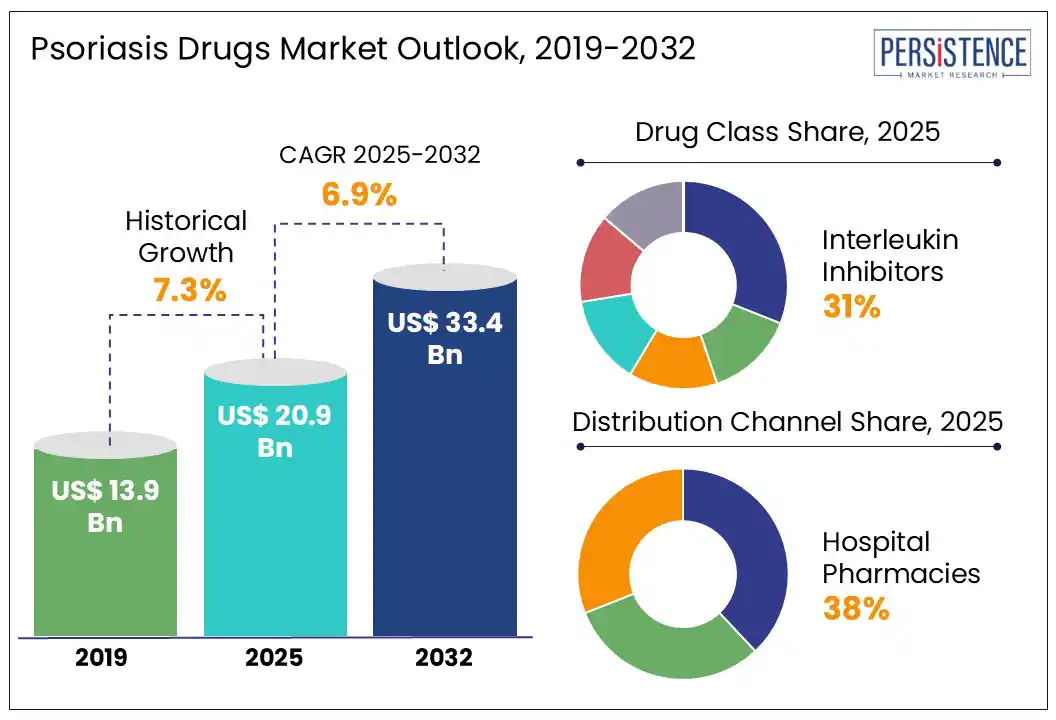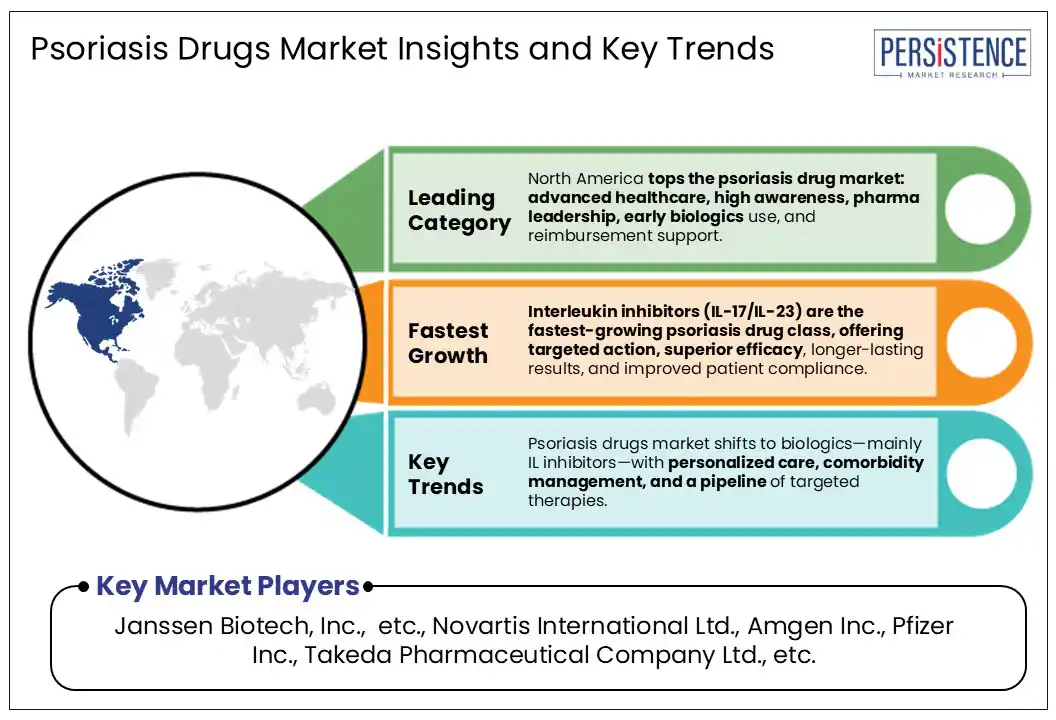ID: PMRREP25102| 195 Pages | 1 Jul 2025 | Format: PDF, Excel, PPT* | Healthcare

The global psoriasis drugs market size is likely to be valued at US$ 20.9 Bn in 2025 and is expected to reach US$ 33.4 Bn by 2032, growing at a CAGR of 6.9% from 2025 to 2032.
According to the Persistence Market Research report, the psoriasis drugs market is witnessing significant growth, driven by rising disease prevalence, improved diagnosis rates, and the introduction of novel biologics. Increasing patient awareness and expanding healthcare access in emerging regions fueling demand for more effective and long-term treatment options. Biologic therapies targeting specific immune pathways, such as IL-17 and IL-23 inhibitors, reshape the treatment landscape. Additionally, the shift toward personalized medicine and ongoing clinical trials for innovative drug candidates continues to attract investments.

Key Industry Highlights:
|
Global Market Attribute |
Key Insights |
|
Psoriasis Drugs Market Size (2025E) |
US$ 20.9 Bn |
|
Market Value Forecast (2032F) |
US$ 33.4 Bn |
|
Projected Growth (CAGR 2025 to 2032) |
6.9% |
|
Historical Market Growth (CAGR 2019 to 2024) |
7.3% |
The rising prevalence of psoriatic arthritis (PsA) is significantly influencing the growth trajectory of the psoriasis drugs market. According to the National Psoriasis Foundation, Psoriatic arthritis, an inflammatory joint condition associated with psoriasis, affects approximately 30% of psoriasis patients and is characterized by painful swelling, stiffness, and joint damage. As awareness of the systemic nature of psoriasis increases among healthcare professionals and patients alike, earlier diagnosis and intervention of psoriatic arthritis have become a clinical priority. This shift is driving demand for dual-action therapies that can effectively manage both dermatologic and rheumatologic symptoms.
Traditional psoriasis treatments, such as topical corticosteroids or phototherapy, are insufficient for PsA patients, who require more potent systemic options. As a result, biologic drugs targeting specific immune pathways, particularly IL-17, IL-23, and TNF-alpha inhibitors, are witnessing increased uptake. Pharmaceutical companies are intensifying research efforts to develop drugs that offer joint protection along with skin clearance, with a focus on long-term safety and quality of life outcomes.
Furthermore, the growing body of clinical evidence linking PsA to increased disability and comorbidities such as cardiovascular disease is prompting payers and policymakers to improve access and reimbursement for advanced therapies. This convergence of medical need and policy support is a key driver of market expansion.
The high cost of novel therapies, particularly biologics like IL-17 and IL-23 inhibitors, remains a significant barrier in the global psoriasis drugs market. These advanced monoclonal antibodies, though highly efficacious, are often priced beyond the affordability range of patients in low- and middle-income countries. Even in high-income regions, limited insurance coverage or high co-pays can hinder patient access. The cost burden doesn't just affect individuals; it also strains national healthcare budgets, especially in countries with universal healthcare systems. As a result, many healthcare providers are reluctant to list or recommend these high-cost therapies as first-line treatments despite their superior efficacy and lower relapse rates compared to conventional drugs.
This pricing imbalance also exacerbates treatment inequality, as patients in wealthier urban centers may access cutting-edge biologics, while rural or economically disadvantaged populations are left reliant on older, less effective, and more side-effect-prone systemic drugs. Additionally, pharmaceutical companies face backlash over pricing policies, delaying market entry in cost-sensitive regions, and discouraging adoption. While biosimilars offer some cost relief, their availability remains limited, and physician hesitation over interchangeability continues to slow uptake. Consequently, the high cost of novel psoriasis therapies continues to serve as a critical restraint, limiting the broader impact of medical innovation on patient outcomes.
The success of mRNA vaccine platforms during the COVID-19 pandemic has catalyzed a paradigm shift in drug development, extending well beyond infectious diseases. One of the most promising frontiers is the application of mRNA-based therapeutics for autoimmune conditions such as psoriasis. Unlike conventional therapies that broadly suppress the immune system or target single cytokines, mRNA technology allows for precise reprogramming of immune responses, enabling the body to produce specific proteins that modulate overactive pathways involved in psoriasis pathogenesis, such as IL-23, IL-17, or TNF-α.
This modality offers personalized treatment opportunities, as mRNA sequences can be rapidly customized to a patient’s unique genetic and inflammatory profile. Moreover, the transient nature of mRNA expression enhances safety, reducing long-term immunosuppression risks. Topical or localized mRNA delivery, still in experimental stages, could further revolutionize treatment by minimizing systemic exposure and maximizing lesion-specific efficacy.
Interleukin (IL) inhibitors, especially IL-17, IL-23, and IL-12/23 inhibitors, have emerged as the gold standard in moderate-to-severe plaque psoriasis treatment due to their high specificity, superior efficacy, rapid skin clearance, and sustained remission. These targeted biologics, including drugs such as secukinumab, ixekizumab, guselkumab, and risankizumab, outperform older treatments by precisely blocking inflammatory cytokine pathways central to psoriasis pathogenesis.
Compared to traditional options like corticosteroids or TNF-α inhibitors, interleukin inhibitors offer better safety profiles with fewer systemic side effects, leading to strong physician preference and patient adherence. Their effectiveness in treating psoriatic arthritis alongside skin symptoms further increases their clinical value. Additionally, continuous innovation, new approvals, and expanding indications globally have reinforced their market dominance.
Plaque psoriasis account for the largest share in the psoriasis drugs market in 2025, due to its dominance as the most commonly diagnosed form of the disease. Characterized by red, and scaly patches on the skin, it often appears on visible areas like the elbows, knees, and scalp, prompting patients to actively seek medical treatment. Its chronic nature and tendency to recur make long-term management necessary, driving continuous demand for therapies. Pharmaceutical companies focus heavily on plaque psoriasis in clinical research and drug development, resulting in a wider range of approved treatments, especially biologics and systemic drugs. This strong clinical attention, combined with higher diagnosis rates and patient awareness, positions plaque psoriasis as the central focus of therapeutic innovation and market revenue.
Hospital pharmacies account for the highest share in the psoriasis drugs market due to their pivotal role in dispensing advanced biologics and specialty therapies, which require stringent storage, administration, and monitoring protocols. Most moderate-to-severe psoriasis patients are treated in hospital settings where dermatologists initiate high-cost biologic treatments like IL-17 or IL-23 inhibitors. These therapies often require in-hospital induction, follow-up dosing, and adverse effect management, reinforcing the hospital pharmacy’s role. Additionally, hospital pharmacies are more integrated with insurance and reimbursement systems, making them preferred points for high-value prescriptions. The growing prevalence of comorbid conditions such as psoriatic arthritis, which also demands multidisciplinary hospital care, further amplifies the reliance on hospital pharmacies over retail and online channels.

The North American psoriasis drugs market, particularly in the U.S., is witnessing a paradigm shift driven by accelerated adoption of next-generation biologics and personalized therapies. The region leads in clinical trial activity and FDA approvals for IL-17 and IL-23 inhibitors, reflecting strong regulatory support and rapid innovation cycles. Increasing diagnosis rates, heightened disease awareness, and favorable reimbursement frameworks are propelling market growth. A distinct trend is the rise of tele-dermatology and biologic self-administration devices, enhancing patient adherence and access. Moreover, the U.S. is at the forefront of integrating pharmacogenomics into psoriasis care, tailoring treatment regimens based on genetic response markers. High healthcare spending, combined with the presence of key biopharma innovators, solidifies North America’s dominance in the global industry.
The European psoriasis drugs market is characterized by a strong shift toward cost-effective biosimilars and value-based treatment models, driven by nationalized healthcare systems and budget constraints. Countries such as Germany, France, and the UK are promoting the uptake of biosimilar versions of TNF-α inhibitors and IL inhibitors to reduce treatment costs without compromising efficacy. Additionally, the EU’s emphasis on patient-centric care is fostering wider adoption of topical therapies and early-intervention regimens in primary care settings. Cross-border research collaborations and pan-European regulatory harmonization are accelerating clinical development pipelines. Moreover, the rising prevalence of lifestyle-related triggers such as obesity and stress is increasing disease incidence.
The Asia Pacific psoriasis drugs market is experiencing dynamic growth due to rising awareness, increasing healthcare access, and a growing patient population suffering from chronic skin conditions. Emerging economies in the region are investing heavily in healthcare infrastructure and expanding insurance coverage, making advanced treatments more accessible. The demand for affordable therapies, including biosimilars and innovative topicals, is gaining momentum among cost-sensitive populations. Additionally, supportive government policies and fast-track regulatory approvals are encouraging pharmaceutical companies to introduce newer formulations. Local manufacturing capabilities are also expanding, enabling faster market penetration. The increasing involvement of regional players in research and development is expected to drive the availability of diverse treatment options tailored to the unique needs of patients in this market.
The global psoriasis drugs market is highly competitive, characterized by the presence of multinational pharmaceutical giants and a growing number of regional biotech firms. Intense R&D activity focuses on developing next-generation biologics, small molecules, and biosimilars to enhance efficacy and reduce treatment costs. Patent expirations are prompting strategic alliances, licensing deals, and acquisitions to strengthen pipelines. Emerging players are disrupting the space with targeted therapies and personalized treatment approaches. Additionally, companies are investing in patient-centric models, real-world evidence studies, and digital therapeutics to differentiate their offerings.
The global psoriasis drugs market is estimated to increase from US$ 20.9 Bn in 2025 to US$ 33.4 Bn in 2032.
An increasing number of people are being diagnosed with various forms of psoriasis, particularly plaque psoriasis, fueling demand for effective treatments.
The market is projected to record a CAGR of 6.9% during the forecast period from 2025 to 2032.
Leveraging genetic and biomarker research to develop tailored treatments enhances efficacy and minimizes side effects, creating niche opportunities.
Janssen Biotech, Inc., Novartis International Ltd., Amgen Inc., Pfizer Inc., and Takeda Pharmaceutical Company Ltd., are the key players within this market space.
|
Report Attribute |
Details |
|
Historical Data/Actuals |
2019 - 2024 |
|
Forecast Period |
2025 - 2032 |
|
Market Analysis Units |
Value: US$ Mn/Bn |
|
Geographical Coverage |
|
|
Segmental Coverage |
|
|
Competitive Analysis |
|
|
Report Highlights |
|
|
Customization and Pricing |
Available upon request |
By Drug Class
By Mode of Administration
By Indication
By Distribution Channel
By Region
Delivery Timelines
For more information on this report and its delivery timelines please get in touch with our sales team.
About Author